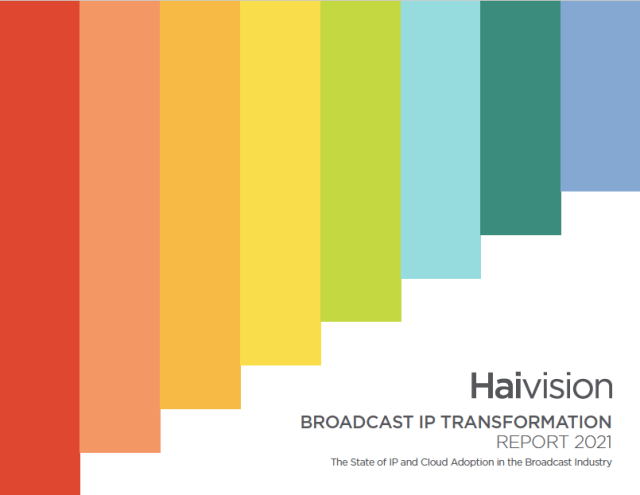
Three recently released reports shed precious light on the live sports production business from various industry angles. They seek to gain a clear understanding of how the COVID-19 pandemic has changed the media consumption experience for fans and equally how it has accelerated sweeping changes to the way live sports are covered and presented by broadcasters and media rights holders.
Stats Perform has issued “Fan Engagement Report: Key Findings from Stats Perform Research on the Current State of Content in Sport.” In the introduction, Nancy Hensley, Chief Product & Marketing Officer, said, “No doubt, as fans begin to return to sports stadiums across the globe there is a renewed sense of optimism about the future of sports media.

“That said, there’s also an acknowledgement that our industry has changed, or perhaps that the pace of change we were already going through has quickened. The reliance on digital mediums as the primary source of engagement, coupled with the continuing levels of innovation in other sectors of media, continues to push sports fans’ expectations higher.”
Among the findings, esports was the most common new addition among report respondents when discussing increased coverage and growth potential. Esports is predicted to nearly double its viewership to 646 million in 2023, from where it stood in 2017. The industry is expected to top $1 billion in revenue in 2021, with over half of the global viewership coming from the APAC region. While the global pandemic has certainly aided in this rapid growth, esports has seen major momentum in recent times.
Women’s sports was another commonly mentioned new addition to coverage for 2021 and beyond. From a financial standpoint, women’s sport is estimated to reach an over $ 1 billion valuation in 2021, making it one of the fastest growing sports verticals in recent history.
The increase in women’s sports could also be driven by the growing demand for equality in sports, according to Stats Perform. When polled on new or developing consumer trends, 40% of respondents said that they are seeing increased pressures from fans to demonstrate moral and social responsibility.
Despite the short-term damage of the global pandemic, the report suggests the sports technology market shows no long-term signs of slowing with expectations that it will register a compound annual growth rate [CAGR] of 16.8% from 2021 to 2028.
“When polled on new or developing consumer trends, 40% of Stats Perform respondents said that they are seeing increased pressures from fans to demonstrate moral and social responsibility.”
While sport was born out of the match or match day experience, the demand for analysis and preview content has morphed into an always-on content opportunity. 53% of research respondents believe there is a growing opportunity to respond to demand for always-on content. What does this content look like? Out ahead is always-on week-round coverage, followed by live coverage during the game, post-game coverage and pre-game coverage.
It’s in the broadcast sector where Stats Perform sees the highest focus on personalization, unsurprisingly coupled with a high focus on keeping fans on platform. The emergence of OTT platforms is providing a path away from a single broadcast experience toward personalized content, which reflects the preferences of the end-user.
A one-size-fits-all policy is no longer sufficient, according to Stats Perform. Content providers need to surface the matches with stories and topics that are relevant to consumers. Tools that help fans find the content they’re after are more valuable than ever and help to get the fan to the content that matters to them – driving better dwell time and ultimately better opportunities for monetization.
Sports Video Trends: Stream It and They Will Come
Grabyo has released its “Sports Video Trends 2021” report, the second in a series beginning in 2019. Grabyo CEO Gareth Capon said, “throughout 2020 and the COVID-19 pandemic, sports broadcasting has gone through a period of rapid change, both in front of the camera and behind the scenes. With sporting venues providing limited capacity of having no fans at all, producing live sport for audiences across the globe has been more important than ever.
“As broadcasters and rights holders have adapted to remote, hybrid and cloud-based working, many have focused on creating more content for fans and testing new innovative formats for TV, digital and social.

“Virtual crowds attending games; more live programming from behind the scenes at venues, training grounds and in player’s homes; TV guests joining studio shows from home via Zoom; and a huge increase in the volume of social video output that tells the story of sport, even without the fans.
“Social video content is also increasingly popular on broadcast TV, with videos of fans celebrating in pubs, outdoor fan parks and at home a key part of the sports news experience,” said Capon. “Sport needs fans and fans need sport: for those that cannot attend events, new video formats are hugely important.
“Fans have responded. Video consumption has increased exponentially in the last year. Consumers have had more time at home, and as a result they have branched out to other sports, leagues and types of content than they would usually watch,” he said.
In 2019, Grabyo released its first Sports Video Trends report, which explored how fans accessed sports content across Europe, the US and Australia. This report expands those insights to get feedback from consumers from across the globe.
Grabyo surveyed over 15,000 consumers from the UK, US, Canada, Australia, France, Spain, Italy, Germany, India, Japan, Thailand, Mexico, Brazil and Argentina, asking which types of content consumers are watching, which video subscriptions they pay for, which device they use and how they see the future of TV and video.
Since 2019, Grabyo’s research has found TV subscriptions in sports fans have dropped 9% globally, while the adoption of streaming services has increased by 41%. More fans are also willing to pay for video services now than in 2019, which can be attributed to the expansion of many streaming services over the past year.
The vast majority of global sports fans indicate that they are willing to move to a streaming-only service that carries live sport. Over half of those surveyed are over 45 years old, which shows that flexible pricing options, increased accessibility and convenience are now highly valued by fans of all ages.
This shift is reflected in the successful growth of sports-focused streaming services such as DAZN, ESPN+ and Kayo Sports, who are changing the landscape for live sports production across their respective markets. The success of these platforms proves one thing for sports streaming services: build it and they will come.
Grabyo’s 2019 Sports Video Trends Report found that 53% of global sports fans that pay for video services were considering cutting the cord by 2024. In 2021, the number of fans paying for streaming services exclusively is 45%.
“Since 2019, Grabyo’s research has found TV subscriptions in sports fans have dropped 9% globally, while the adoption of streaming services has increased by 41%.”
By 2026, the data suggests that the broadcast TV market will only have a 28% customer share of global sports fans. Broadcasters and sporting rights holders must begin prioritizing their video strategies to match what fans demand. Those who adapt will win, according to Grabyo: ESPN+ already has over 13 million subscribers paying around $6 per month, while DAZN continually achieves rapid global growth.
Competition for audiences spans multiple platforms and devices. Sports fans are looking for a wide breadth of content, from live sports to behind the scenes interviews, and have strong preferences about where each format of content should be available. The growth of social media use has led to an increase in demand for sports content that is optimized for mobile viewing — including live sport and events.
A greater number of sports fans use social media to watch video regularly than pay-TV and free-to-air TV. While this is not a comparison of minutes watched, Grabyo feels it reflects a new perception that social media is now on equal footing with broadcast TV as a destination for sports video content.
Which devices are global sports fans using to watch video? Smart TV and smartphone lead with 56%, followed by laptop/desktop on 46%, tablet 30%, traditional TV 23%, cable box/STB 23%, streaming devices 20% and games consoles at 14%.
Which social media platforms are fans using to watch video globally? According to the Grabyo report YouTube is way out in front with 90%, followed by Facebook (65%), Instagram (50%), TikTok (35%), Twitter (27%), Snapchat (15%), and Twitch (13%).
Staying at Home to Produce Remote Live Sports Events
Meanwhile, Haivision has released its second “Broadcast IP Transformation Report 2021: The State of IP and Cloud Adoption in the Broadcast Industry.”
“When we published the results of our first report in early 2020, never could we have imagined the enormous disruption and uncertainty that was about to unfold,” said Haivision chief commercial officer and SVP strategic relationships Peter Haag in his introduction. “From lockdowns and social distancing measures to remote working, the COVID-19 pandemic has impacted every aspect of our lives, both professionally and personally.
“For the media and broadcast industry, the new reality taking shape is one of complexity and opportunity, forcing creative use of technology and innovative workflows. With ever-increasing demand for content, significant changes in viewing behavior, and the emergence of new “nimble” players in the market, the broadcast industry continues to evolve and shift.
“Throughout November and December 2020, we conducted our second survey among broadcasters worldwide to gain a clearer insight into what challenges they are facing and what technologies they are currently using and planning to invest in. We also wanted to find out exactly how COVID-19 has impacted the transition to IP and cloud technologies and whether these changes will become permanent. What we learned is fascinating,” said Haag.

The pandemic has significantly impacted how broadcasters are operating. While the transition towards IP was already on the agenda, 71% of those polled stated that COVID-19 has accelerated the adoption process within their organization.
When covering live events, broadcasters are increasingly turning to remote production. 39% of those surveyed are employing remote production or REMI workflows. Almost half of those surveyed (46%) also indicated that REMI/At-Home technology is one of the most important trends for their organization in the future.
When asked about their biggest challenges, the responses from Haivision’s survey of broadcast professionals were clear: 42% cited transitioning to IP, closely followed by enabling remote collaboration at 41%.
With over 50% of respondents already using HEVC and over 80% planning to this year, HEVC is clearly becoming the most important codec for the future of broadcast video. This is largely due to the growing importance of 4K UHD video contribution over IP and the cloud.
In an industry synonymous with television studios and master control rooms, the pandemic has radically changed the way broadcast production staff and talent work. Confined to home offices while at the same time keeping travel to a minimum, broadcast professionals are having to leverage IP streaming technology to closely collaborate with their peers while delivering engaging real-time content to viewers, who are also stuck at home and consuming more video than ever before.
Despite the hardships caused by the pandemic, video streaming and virtual desktop technology have matured to the level where it can replace traditional facility-based workflows, according to the Haivision report. At the time the survey was conducted in late 2020, some of the largest names in the broadcast industry had as many as 75% or more of their employees successfully producing quality live content from home.
“Despite the hardships caused by the pandemic, video streaming and virtual desktop technology have matured to the level where it can replace traditional facility-based workflows, according to the Haivision report.”
A small minority of broadcasters responded that they are running their entire workflow in the cloud, an approach that looks likely to grow over time. Just over half have less than 25% of their workflow elements deployed in the cloud, indicating that there is still a long way to go.
44% of survey respondents have somewhere between 25-75% of their workflows based on cloud technology. Although it’s hard to tell how many of the latter group will transition to 100% cloud-based workflows, Haivision expects that cloud solutions will play an increasingly significant role across the board as broadcasters look to continue supporting remote contribution, remote collaboration, and live OTT services.
In last year’s survey, it took the number one spot and in 2020, 5G remained on the top of the list of technologies that will impact broadcasting within the next five years, according to 64% of respondents. Broadband internet access will become truly ubiquitous as 5G mobile gateways complement Ethernet links and spur more IP streaming applications including contribution and mobile remote collaboration.
5G’s greater throughput is also critical for technologies like 4K UHD streaming which is second on the list according to 45% of respondents. With most households now owning a large TV screen, being able to produce live content in 4K will be increasingly critical when delivering premium viewer experiences and will require the bandwidth efficient HEVC codec for IP workflows.
For non-compressed video, SMPTE 2110, the third most impactful technology over the course of the next five years, will need to be able to support 4K UHD video and HDR. Broadcasters need to consider all these technologies when designing their content production workflows.




